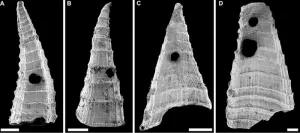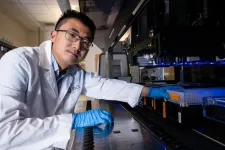(Press-News.org) A new study from Vanderbilt University Medical Center shows that clinical alerts driven by artificial intelligence (AI) can help doctors identify patients at risk for suicide, potentially improving prevention efforts in routine medical settings.
A team led by Colin Walsh, MD, MA, associate professor of Biomedical Informatics, Medicine and Psychiatry, tested whether their AI system, called the Vanderbilt Suicide Attempt and Ideation Likelihood model (VSAIL), could effectively prompt doctors in three neurology clinics at VUMC to screen patients for suicide risk during regular clinic visits.
The study, reported in JAMA Network Open, compared two approaches — automatic pop-up alerts that interrupted the doctor's workflow versus a more passive system that simply displayed risk information in the patient's electronic chart.
The study found that the interruptive alerts were far more effective, leading doctors to conduct suicide risk assessments in connection with 42% of screening alerts, compared to just 4% with the passive system.
"Most people who die by suicide have seen a health care provider in the year before their death, often for reasons unrelated to mental health," Walsh said. "But universal screening isn't practical in every setting. We developed VSAIL to help identify high-risk patients and prompt focused screening conversations."
Suicide has been on the rise in the U.S. for a generation and is estimated to claim the lives of 14.2 in 100,000 Americans each year, making it the nation’s 11th leading cause of death. Studies have shown that 77% of people who die by suicide have contact with primary care providers in the year before their death.
Calls to improve risk screening have led researchers to explore ways to identify patients most in need of assessment. The VSAIL model, which Walsh's team developed at Vanderbilt, analyzes routine information from electronic health records to calculate a patient's 30-day risk of suicide attempt. In earlier prospective testing, where VUMC patient records were flagged but no alerts were fired, the model proved effective at identifying high-risk patients, with one in 23 individuals flagged by the system later reporting suicidal thoughts.
In the new study, when patients identified as high-risk by VSAIL came for appointments at Vanderbilt's neurology clinics, their doctors received on a randomized basis either the interruptive or non-interruptive alerts. The research focused on neurology clinics because certain neurological conditions are associated with increased suicide risk.
The researchers suggested that similar systems could be tested in other medical settings.
"The automated system flagged only about 8% of all patient visits for screening," Walsh said. "This selective approach makes it more feasible for busy clinics to implement suicide prevention efforts."
The study involved 7,732 patient visits over six months, prompting 596 total screening alerts. During the 30-day follow-up period, in a review of VUMC health records, no patients in either randomized alert group were found to have experienced episodes of suicidal ideation or attempted suicide. While the interruptive alerts were more effective at prompting screenings, they could potentially contribute to "alert fatigue" — when doctors become overwhelmed by frequent automated notifications. The researchers noted that future studies should examine this concern.
"Health care systems need to balance the effectiveness of interruptive alerts against their potential downsides," Walsh said. "But these results suggest that automated risk detection combined with well-designed alerts could help us identify more patients who need suicide prevention services."
Others on the study from VUMC included Michael Ripperger, BS, Laurie Novak, PhD, Carrie Reale, MSN, Shilo Anders, PhD, Ashley Spann, MD, Jhansi Kolli, BS, Katelyn Robinson, BA, Qingxia Chen, PhD, David Isaacs, MD, Lealani Mae Acosta, MD, Fenna Phibbs, MD, Elliot Fielstein, PhD, Drew Wilimitis, BS, Katherine Musacchio Schafer, PhD, Dan Albert, MS, Jill Shelton, BSN, Jessica Stroh, BSN, and co-senior authors William Stead, MD, and Kevin Johnson, MD, MS.
The study was supported by the Evelyn Selby Stead Fund for Innovation (VUMC), FDA Sentinel, Wellcome Leap MCPsych, and the National Institutes of Health (grants MH118233, MH12145 MH116269, MH120122, HG009034, HG012510).
END
AI system helps doctors identify patients at risk for suicide
Automated system developed at Vanderbilt University Medical Center flagged about 8% of patient visits for screening
2025-01-03
ELSE PRESS RELEASES FROM THIS DATE:
Advanced imaging uncovers hidden metastases in high-risk prostate cancer cases
2025-01-03
A new study led by researchers at the UCLA Health Jonsson Comprehensive Cancer Center has found that many cases of high-risk nonmetastatic hormone-sensitive prostate cancer may be more advanced than previously thought.
The study, published in JAMA Network Open, found that nearly half of high-risk prostate cancer patients previously classified as nonmetastatic by conventional imaging actually have metastatic disease when evaluated with advanced prostate-specific membrane antigen–positron emission tomography (PSMA-PET) ...
Study reveals oldest-known evolutionary “arms race”
2025-01-03
A new study led by researchers at the American Museum of Natural History presents the oldest known example in the fossil record of an evolutionary arms race. These 517-million-year-old predator-prey interactions occurred in the ocean covering what is now South Australia between a small, shelled animal distantly related to brachiopods and an unknown marine animal capable of piercing its shell. Described today in the journal Current Biology, the study provides the first demonstrable record of an evolutionary arms race in the Cambrian.
“Predator-prey interactions are often touted as a major driver of the Cambrian explosion, ...
People find medical test results hard to understand, increasing overall worry
2025-01-03
In April 2021, a provision in the 21st Century Cures act took effect which required that all medical test results be released to a patient’s electronic medical record as soon as they become available.
As a result of this newer law, many patients are seeing and reading their test results even before their doctor has.
The problem is that many medical reports aren’t written with patients in mind.
For example, “a standard pathology report is written by a pathologist for a clinical specialist like a surgeon or ...
Mizzou researchers aim to reduce avoidable hospitalizations for nursing home residents with dementia
2025-01-03
COLUMBIA, Mo. -- For many nursing home residents, a trip to the hospital can be a jarring experience — one that leaves them confused and stressed. Yet avoidable transfers happen far too often, not only disrupting a resident’s routine but also costing the U.S. healthcare system $2.6 billion annually.
When researchers at the University of Missouri recently looked at the decision-making process for whether or not to transfer nursing home residents to the hospital, they quickly discovered that it’s complicated — particularly for residents with cognitive impairment who may not ...
National Diabetes Prevention Program saves costs for enrollees
2025-01-03
About 1 in 3 adults in the United States have prediabetes, a condition where blood glucose levels are higher than normal, but not high enough to be diagnosed as diabetes.
Affecting 98 million adults, prediabetes can increase the risk of heart disease, stroke and type 2 diabetes.
While it can be reversed, 8 in 10 adults are unaware that they even have prediabetes.
To counter this growing problem, the National Diabetes Prevention Program was created by the Centers for Disease Control and ...
Research team to study critical aspects of Alzheimer’s and dementia healthcare delivery
2025-01-03
Kosali Simon, PhD, M.A., a professor with the Paul H. O’Neill School of Public and Environmental Affairs and a Regenstrief Institute research scientist; and Katherine Baicker, PhD, University of Chicago provost, will co-lead an expected nearly $16 million National Institutes of Health’s (NIH) National Institute on Aging (NIA) program to explore critical aspects of healthcare delivery for individuals living with Alzheimer’s disease and related dementias (ADRD).
This five-year research initiative aims to identify and address barriers to equitable and effective healthcare for this growing patient population. The ...
Major breakthrough for ‘smart cell’ design
2025-01-03
HOUSTON – (Jan. 3, 2025) – Rice University bioengineers have developed a new construction kit for building custom sense-and-respond circuits in human cells. The research, published in the journal Science, represents a major breakthrough in the field of synthetic biology that could revolutionize therapies for complex conditions like autoimmune disease and cancer.
“Imagine tiny processors inside cells made of proteins that can ‘decide’ how to respond to specific signals like inflammation, tumor growth markers or blood sugar levels,” said Xiaoyu Yang, a graduate ...
From CO2 to acetaldehyde: Towards greener industrial chemistry
2025-01-03
Acetaldehyde is a vital chemical used in making everything from perfumes to plastics. Today, its production largely relies on ethylene, a petrochemical. But increasing environmental concerns are pushing the chemical industry to reduce its reliance on fossil fuels, so scientists have been searching for greener ways to produce acetaldehyde.
Currently, acetaldehyde is produced through the so-called “Wacker process”, a chemical synthesis method that uses ethylene from oil and natural gas with other chemicals such as strong acids, i.e. hydrochloric acid. The Wacker process not only has a large carbon footprint ...
Unlocking proteostasis: A new frontier in the fight against neurodegenerative diseases like Alzheimer's
2025-01-03
Scientists have uncovered a powerful ally in the fight against neurodegenerative diseases: a nucleolar complex that plays a pivotal role in maintaining cellular health through protein homeostasis (proteostasis), by which cells maintain the balance and proper functioning of their proteins. By suppressing this complex, researchers have shown it’s possible to dramatically reduce the toxic effects of Alzheimer’s-causing proteins, boosting the cell’s natural defenses through enhanced degradation of hazardous proteins. This mechanism regulates proteostasis across tissues by modulating TGF-β signaling, a pathway involved in cell growth, differentiation, ...
New nanocrystal material a key step toward faster, more energy-efficient computing
2025-01-03
CORVALLIS, Ore. – Scientists including an Oregon State University chemistry researcher have taken a key step toward faster, more energy-efficient artificial intelligence, and data processing in general, with the discovery of luminescent nanocrystals that can be quickly toggled from light to dark and back again.
“The extraordinary switching and memory capabilities of these nanocrystals may one day become integral to optical computing – a way to rapidly process and store information using light particles, which travel faster than anything in the ...
LAST 30 PRESS RELEASES:
How many insects fly in the sky above the USA?
Could cheese protect your brain health?
Who faces more difficulty recovering from stroke?
Colliding galaxies create the brightest, fastest growing black holes at their center
New BrainHealth research reveals tradeoffs on sleep with cannabis use for chronic pain
Aging-US now on ResearchGate, enhancing visibility for authors and readers
'Molecular glue' stabilizes protein that inhibits development of non-small cell lung cancer
Mount Sinai Health System is recognized in 2025 Chime Digital Health Most Wired survey
From prey to predator: How carnivores spread beneficial fungi
Menopause symptoms may be frequent and have negative effects, according to female endurance athletes
US Congressmembers’ responses on X to mass shooting events differ along party lines
KAIST-UEL team develops “origami” airless wheel to explore lunar caves
Individual genetic differences render some therapies ineffective
Engineering dendritic cells boosts cancer immunotherapy
Sophisticated neuroimaging reveals PTSD in WTC responders is linked to measurable physical changes in brain structure
Health policy experts identify promising strategies for providing health care to homeless people
Study explores role of neutrophils in canine atopic dermatitis
Mayo Clinic researchers develop AI-ECG model to diagnose liver disease earlier
Heavy menstruation common among teenage girls – questionnaire reveals risk of iron deficiency
New study explores why open water swimming feels so powerful for midlife women
In echo of Jurassic Park, mosquitoes capture entire ecosystems in their blood meals
Marty Cooper, Illinois Tech Alumnus and ‘Father of the Cell Phone,’ Receives 2025 Marconi Society Lifetime Achievement Award
How to reduce the risk of lymphedema
NEJM Evidence and CIDRAP announce Public Health Alerts
New fossil study illuminates on the evolutionary success of frogs
Patient-specific human liver model to understand disease mechanisms
Confused by the doctor's questionnaire? U of A study suggests it's common
How do brains stay stable, and when might a dose of flexibility be helpful?
mRNA revitalizes aging immune systems—the liver as a fountain of youth
Rural-urban differences in the prevalence of chronic pain among adult cancer survivors
[Press-News.org] AI system helps doctors identify patients at risk for suicideAutomated system developed at Vanderbilt University Medical Center flagged about 8% of patient visits for screening





